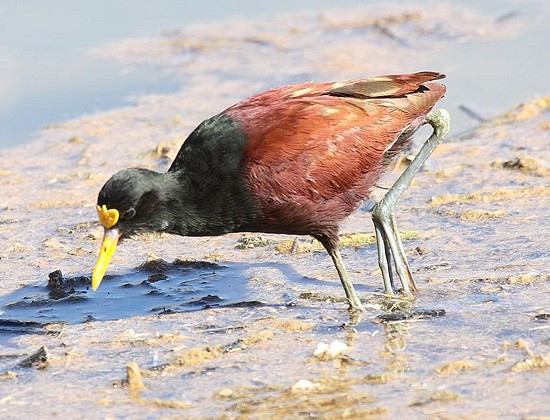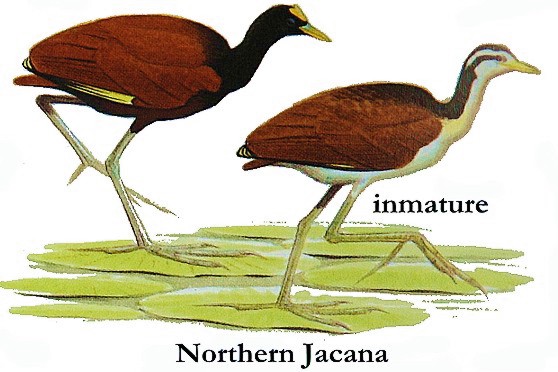Lessico
Jacana spinosa

Gli Jacanidi appartengono alla famiglia dei Caradriiformi che sono caratterizzati dall'estremo sviluppo in lunghezza delle dita, tale da consentire loro di spostarsi con grande facilitÓ sulla vegetazione galleggiante. Le ali poco sviluppate, sono di forma tondeggiante. Comprendono jacane, parre e idrofagiani e vivono nelle zone tropicali di tutti i continenti, Oceania esclusa.
La jacana spinosa (Jacana spinosa, Linnaeus 1758) Ŕ appunto un uccello della famiglia Jacanidae dell'ordine dei Charadriiformes. Esistono cinque sottospecie di Jacana spinosa: dorsalis, gymnostoma, lowi, spinosa, violacea. Uccello dalle lunghe zampe, la jacana pu˛ spostarsi sulla vegetazione che galleggia a pelo d'acqua, quali le ninfee e.ci˛ le permette di cibarsi pi¨ facilmente. Caccia soprattutto insetti, piccoli invertebrati e semi caduti sulla vegetazione o sulla superficie dell'acqua. Questo uccello vive in Centro America, dal sud degli Stati Uniti (Texas e Florida in particolare) fino a Panamß, comprese le isole dei Caraibi non troppo esterne (Giamaica, Cuba, Porto Rico, etc).
The Northern Jacana or Northern Jašana (Jacana spinosa) is a wader which is a resident breeder from coastal Mexico to western Panama, and on Cuba, Jamaica and Hispaniola. It sometimes breeds in Texas, USA, and has also been recorded on several occasions as a vagrant in Arizona. The jacanas are a group of wetland birds, which are identifiable by their huge feet and claws which enable them to walk on floating vegetation in the shallow lakes that are their preferred habitat. They are found worldwide within the tropical zone.
The Northern Jacana lays four black-marked brown eggs in a floating nest. The male, as with other jacanas, and some other wader families like the phalaropes, takes responsibility for incubation, with two eggs held between each wing and the breast. The females are polyandrous, and will help to defend the nests of up to four mates. These are conspicuous and unmistakable birds, with all three races being very similar. They are 17ľ23cm long, but the females are larger than the males. The adults have a chestnut back and wing coverts, with the rest of the body mainly black. In flight the greenish yellow flight feathers are obvious. The yellow bill extends up as a coot-like head shield and the legs and very long toes are dull yellow. There is a long sharp spur on the bend of the wing. This species produces a range of noisy rattling calls.
Young birds initially have entirely white underparts, and can always be identified by the presence of white in their plumage. This species is very similar to the Wattled Jacana (Jacana jacana), with which it overlaps in Panama, and was formerly considered conspecific with that form. The main differences are that Wattled has a red frontal shield and a reddish rictal wattle, and lacks the slight brownish tint to the belly plumage of Northern. However, juveniles can be difficult to identify, since the only distinction is the shape of the tiny developing frontal shield.
The Northern Jacana's food is insects, other invertebrates and seeds picked from the floating vegetation or the water's surface. In Jamaica this bird is also known as the 'Jesus bird', as it appears to walk on water. Jacana is one LinnŠus' pseudo-Latin misspelling for the Brazilian Portuguese JašanŃ (from a Tupi name of the same bird).
